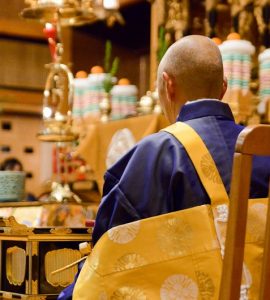
By Rev. Ryoko Osa
We all know death is a fact of life, but how about our “second death”?
Imagine 100 years after your death, probably no one alive will have known you or met you directly. Like in the movie “Coco,” human beings experience two deaths. The “first death” is physical—the death of the body. The “second death” is the moment no one remembers you. It’s an idea that seems to say memory is what life is really about.
If one day you suffer from dementia, then you’d likely face a deep fear that you were losing yourself, or what you thought of as “myself.” However, even among the young, there is a kind of memory disorder where memories last only a few hours. How can we ever accept either of these conditions?
Losing my memory is a scary thought. On the other hand, people suffering from unbearable memories of painful events—such as violence, abuse, and even murder—may be relieved to forget. A key question remains: Does personal memory define the self?
To help us remember people from the past, Jodo Shinshu memorial services continue for the deceased up until the 50th year anniversary of their passing. For example, if a 10-year-old granddaughter were to lose her grandfather, the 50th anniversary memorial for him would be held when she turned 59. In this case she will surely remember him, even after many years have passed. Although today, 50th anniversary memorial services for family members are rare, this tradition continues for a reason—because it helps family members remember the deceased. Of course, Buddhist memorial services also are occasions to listen to the Buddha’s teachings.
Here I would like to address the connection between memory and Amida Buddha’s primal vow. Amida’s primal vow is the vow to liberate all sentient beings from their suffering.
This vow took shape when the Bodhisattva Dharmakara was following practices to become a Buddha. The direct translation of Hongan (Buddha’s vow) is “original vow.” It’s a vow that goes back countless eons in the past. We tend to think about life and death based on our own lifespans, but primal vows are based on a different concept of time, beyond our ability to comprehend. Indeed, it’s said these vows have no beginning point in time.
According to Buddhism, our subconscious is like a storehouse in which all histories, from the immeasurable past, are stored. Even if we cannot remember or be aware of those histories, all the world’s past events have come to be stored within our subconscious. We might think of the subconscious as a huge backup drive of all history, which forms for basis for our biological instincts, or life force, as living beings.
By thinking beyond one’s body and consciousness to a universal storehouse of memory, we truly can awaken to our own impermanence. By listening to the Buddha’s vow, we can reach a state of freedom and oneness that transcends this kind of subjectivity- objectivity paradigm.
To use a metaphor of the ocean: “I” is the shape of a wave appearing on the water’s surface, while deep in the ocean there’s a storehouse of memories past which “I” cannot even imagine—memories which I share with other lives. However, “I” instinctively feels these memories are calling me to survive and live.
Even if individual remembrances are forgotten, we still are connected through this store of memories. After physical death, we truly melt with others in the great ocean of the Hongan, the primal vow.
A hundred years from now, probably no one will have known us directly. But 100 years from now we will be stored in the memory of future sentient beings and will serve as the vital force of other lives.
Now, at this moment, past histories lie in our subconscious, giving us the power to live. Our life is not an individual life, but a life connected to all lives that have come before us.
Rev. Osa is minister of Berkeley Higashi Honganji in California.

